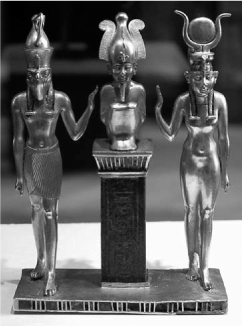Egyptian MythologyThe Myth of Isis, Osiris, and Horus |
What was the cult of Isis and Osiris and Horus? |
After Ra’s withdrawal from daily concerns with earth, his son Geb became the ruler of earth. Eventually Geb ceded his position to his son Osiris. More than any other deities, Osiris, his wife Isis, and their son Horus played out their mythological roles on earth rather than in heaven. Osiris and Isis, acting as culture heroes, were associated with humanity, teaching the people agriculture and the art of civilization in general. Their human aspect made Osiris and Isis and Horus eligible to play jointly the mythological role of the monomythic hero. In their story we find the theme of the miraculous conception and birth, the threat to the hero’s life, the death of the hero, and the hero’s resurrection and return. The Osiris/Isis/Horus cult was the central one in Egyptian religion for many centuries. It was the myth that most directly connected the people to the gods. All kings died as Osiris and were crowned as Horus (Osiris resurrected).
The Osiris/Isis/Horus myth is told in various versions in the Pyramid Text and the Coffin Texts, in the Book of the Dead, and in the writings of the first century C.E. Greek historian and biographer Plutarch in his Moralia. A combination of the stories related in these sources reveals what has become the canonical (generally accepted, official) myth.

The Egyptian god Osiris (middle) is flanked by his wife, Isis (left), and their son, Horus (right). The Osiris/Isis/Horus cult was the central one in Egyptian religion for many centuries.
